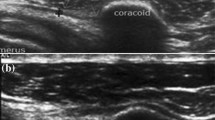Summary
A prospective study of randomized analysis treatment of 50 cases of frozen shoulder was carried out in 3 Swiss medical centres. Three separate aetiological groups were studied: post-traumatic (40%), neurological (14%) and idiopathic (46%). An increased radioisotope bone scan (99 mTc diphosphonate) was found in 96% of cases, regardless of aetiology. The so-called idiopathic frozen shoulder showed a scapulo-humeral increase in radioisotope uptake in several areas (in 82% of cases) without involvement of the ipsilateral carpus. Clinically, the neurological type was associated with a shoulder-hand syndrome with positive bone scan of the shoulder and the wrist in all cases. The post-traumatic type showed a diffuse (in 50% of the cases) or at several circumscribed areas (also in 50%) increase in radioisotope uptake in the shoulder. In 45% of the post-traumatic type, there was also a shoulder-hand syndrome with uptake in the wrist also. A physical treatment and early mobilization, associated with the administration of subcutaneous salmon calcitonin for 21 days (100 U Calcitonin® Sandoz) had a statistically significant increased effect on pain compared to treatment with physiotherapy alone by patients with post-traumatic frozen shoulders (p<0.02). There was no significant difference, however, in the speed of recovery of function between the two treatment groups. These observations strengthen the hypothesis that adhesive capsulitis behave like an algoneurodystrophic process.
Similar content being viewed by others
References
Arlet, J. Les capsulites de l'épaule. Données cliniques. Mesures thérapeutiques. Ann Med Phys 1975, 18, 2, 188–95.
Hubault, A. Les rétractions capsulaires et leurs expressions cliniques. Problèmes actuels de rhumatologie, Zollikofer 1985, 200–11.
Lundberg, B.J. The frozen shoulder. Acta Orthop Scand 1969, suppl. 119.
Neviaser, J.S. Adhesive capsulitis of the shoulder: A study of the pathologic findings in periarthritis of the shoulder. J Bone Joint Surg 1945, 27, 211–22.
Troisier, O. Les capsulites de l'épaule; techniques de mensuration des mouvements et applications cliniques. Rhumatologie 1958, 3, 113–24.
Troisier, O. L'épaule enraidie. Epaule et médecine de rééducation, Masson 9, 1984, 103–08.
Simmonds, F.A. Shoulder pain with particular reference to frozen shoulder. J Bone Joint Surg 1979, 31B, 426–32.
Binder, A.I., Bulgen, D.Y., Hazleman, B.L., Roberts, S. Frozen shoulder: a longterm prospective study. Ann Rheum Dis 1984, 43, 361–64.
Reeves, B. The natural history of frozen shoulder syndrome. Scand J Rheumatol 1975, 4, 193–96.
Sany, J., Caillens, J-P., Rousseau, J.R. Evolution lointaine de la rétraction capsulaire de l'épaule. Rev Rhum 1982, 49 (11), 815–19.
Lequesne, M., Auquier, L. Etiologie et pathogénie de la rétraction capsulaire de l'épaule. Rôle du système nerveux végétatif. Rev. Prat. 1968, 18, 2, 189–96.
Tewfik, E.R., Pinals, P.S. Frozen shoulder. Semin Arthritis Rheum 1982, 11, 4, 440–52.
Binder, A.I., Bugen, D.Y., Hazleman, B.L., Roberts, S. Frozen shoulder: an arthrographic and radionuclear scan assessment. Ann Rheum Dis 1984, 43, 365–69.
Roy, S., Oldham, R., Nichol, F.E. Frozen shoulder: adhesive capsulitis. Br Med J 1982, 284, 117–18.
Stodell, M.A., Sturrock, R.D. Frozen shoulder. Lancet 1981, 2, 527.
Thrall, J.H., Gh Ghaed, N., Geolien, G.E., Pinsky, S.M., John, M.C. Pittalls in 99 mTc polyphosphate skeletal imaging. Am J Roetgenol 1974, 121, 739–47.
Kozin, F., Ryan, L.M., Carerra, G.F., Soin, J.S., Wortmann, R.L. The reflex sympathetic dystrophy syndrome (RSDS). III. Scintigraphic studies, further evidence for the therapeutic efficacy of systemic corticosteroids, and proposed diagnostic criteria. Am J Med 1981, 70, 23–30.
Aussedat, R., Tonnel, F., Pere, P., Hocquard, C., Pourel, J., Gaucher, A. Exploration scintigraphique au cours les algodystrophies sympathiques réflexes. In: Simon, L., Herisson Ch., Les algodystrophies sympathiques réflexes: Masson. 1987: 46–54.
Steinbrocker, O., Spitzer, N., Friedman, H.H. The shoulder-hand syndrome in reflex dystrophy of the upper extremity. Ann Int Med 1948, 29, 22–52.
Doury, P., Pattin, S., Eulry, F., et al. Algodystrophie du genou⪟t scanographie. Rev Rhum 1987, 54 (11) 725–29.
Gobelet, C., Meier, J.-L., Schaffner, W., Bischof-Delaloye, A., Gerster, J-C, Burckhardt, P. Calcitonin and reflex sympathetic dystrophy syndrome. Clin Rheumatol 1986, 5 (3), 382–88.
Author information
Authors and Affiliations
Rights and permissions
About this article
Cite this article
Waldburger, M., Meier, J.L. & Gobelet, C. The frozen shoulder: Diagnosis and treatment. Prospective study of 50 cases of adhesive capsulitis. Clin Rheumatol 11, 364–368 (1992). https://doi.org/10.1007/BF02207194
Received:
Revised:
Accepted:
Published:
Issue Date:
DOI: https://doi.org/10.1007/BF02207194




